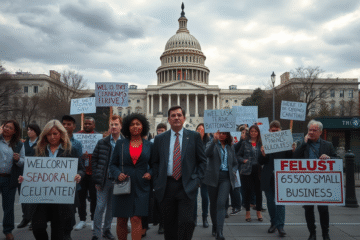50% Tariff Threatens Brazilian Products
Product Rate Brazilian goods exported to the United States are about to undergo a significant change starting August 6, 2025. With the implementation of a 50% tariff on most items, except for 694 products that will pay 10%, this new policy aims to balance the American trade balance, which has remained favorable to the United States since 2009. In this article, we will explore the expected economic impacts for Brazil, the political justifications behind this measure, and the consequences for Brazilian companies, in addition to discussing possible actions in the WTO to mitigate the damage.
New Tariffs on Brazilian Exports to the US
From August 6, 2025, Brazilian products face a tariff of 50% when exported to the United States, impacting companies and the national economy.
Meanwhile, a specific list of 694 items will maintain a reduced tariff of 10%, representing an attempt by the American government to balance its trade balance, according to information indicated in the The Globe.
This change illustrates a new dynamic in trade relations between the two countries, requiring a reassessment of export strategies in Brazil.
In a scenario where the Brazil already faces internal challenges, this new tariff further complicates the sustainability of several industries, some of which are already struggling, as highlighted by recent news.
The implementation of these tariffs generates a debate on economic and commercial alternatives to minimize losses and maintain the competitiveness of Brazilian products in the North American market.
In response, the Brazilian government is formulating a contingency plan with strategic actions to support the impacted sectors
Below is a list of the impacts:
- Products subject to 50%: Most Brazilian exported products will face this high tariff, affecting everything from agribusiness to the manufacturing sector.
- Products that maintain 10%: There are 694 items that still pay the lowest tariff, including sectors considered essential to the Brazilian economy, such as pharmaceuticals and processed foods.
Impact on the Trade Balance between Brazil and the USA
Since 2009, the United States has benefited from a scenario of continuous trade surplus with Brazil, consolidating a position of economic advantage in relation to the South American country.
Data from the first half of 2025 highlights this trend, with a surplus of US$ 1.674 billion becoming clear in the trade balance between the two nations.
This context of commercial superiority, accentuated by successive years of Brazilian deficit, served as justification for the recent imposition of punitive tariffs by the US on Brazilian products.
High tariffs, which affect 50% of most Brazilian exports, with the exception of 694 items, reflect an attempt by Washington to rebalance trade, protecting national industries and emphasizing a more aggressive stance towards international trade.
The consequences of this measure are significant for the Brazilian economy, as a negative impact on economic activity has already been observed, requiring the consideration of compensatory measures and legal strategies to mitigate the damage caused by such a trade policy.
In this way, the tariff decision is based on a long-standing history of unfavorable trade balance for Brazil, becoming both an economic and a political issue.
Political Justifications for Raising Tariffs
The United States' decision to impose a 50% tariff on Brazilian products, as reported by BBC, is more than just a commercial issue.
This measure aims to signal a clear political punishment to Brazil.
The US government argues that Brazil adopts trade barriers, but the application of this tariff aims to go beyond that.
Tariff policy seeks to create an intense diplomatic impact, putting economic pressure on vulnerable sectors of the Brazilian economy.
This strategic move by the US highlights how trade becomes a tool in geopolitics.
The impact on the Brazilian economy projects a drop in GDP, affecting small and medium-sized companies.
US companies show concern.
Meanwhile, Brazil is preparing to respond, considering measures at the WTO to mitigate these effects.
The situation highlights the complexity of international relations and global economic interdependence.
Economic Forecast for Brazil after the New Tariffs
The new tariffs imposed by the US, which increase the costs of Brazilian products by 50%, have a significant impact on the Brazilian economy.
GDP is estimated to suffer a reduction between 0,25% It is 0,6%, reflecting a significant obstacle to the country's economic growth.
Small and medium-sized businesses are the most vulnerable, already having to face challenges such as layoffs and reduced activities.
These effects not only affect domestic growth, but also put important sectors at risk, worsening Brazil's overall economic situation.
To mitigate the impacts, there is a contingency plan under development, in addition to discussions for possible actions in WTO to combat the economic damage inflicted on the country.
| Sector | Impact |
|---|---|
| Agribusiness | Falling revenue and profit margins |
| Metallurgy | Increased costs and cuts in investments |
| Textile | Loss of external competitiveness |
| IT & Services | Reduction in demand from exporting customers |
Challenges Faced by Brazilian Companies
The recent US tariffs are aimed at balancing the trade balance, but they have had a profound impact on small and medium-sized Brazilian companies that depend on exports to the United States.
Rising operating costs and reduced demand have left business owners worried about the future.
Exporter reports express deep concern about their ability to maintain operations as layoffs become inevitable.
The tariff increase to 50% makes products 36% more expensive, further worsening the situation and continually putting thousands of jobs at risk.
Among the main challenges faced are:
- Layoffs in scale
- Reduction of productive activities adapting to new market conditions
- Financial difficulties with lower revenues
However, seek new markets becomes a crucial exit.
Many companies are considering diversifying their markets and trading partners to alleviate the pressure of these tariffs.
This path, although promising, requires time and resources, further challenging the export sector.
The contingency plan being developed by the Brazilian government is a promise of support, but the process will be slow and will have immediate impacts on the economy.
Yet, the hope of reversing this scenario lies in political and diplomatic measures that can mitigate the damage and restore confidence in international trade relations.
Contingency Plan and Actions at the World Trade Organization
To mitigate the negative impacts of tariffs imposed by the United States, Brazil is developing a contingency plan to support the most affected economic sectors.
This plan includes several strategic measures to maintain economic stability and competitiveness on the global stage.
Emergency credit lines: The Brazilian government will strengthen credit lines and subsidies aimed primarily at small and medium-sized companies, allowing these organizations to maintain their operations even in times of financial crisis.
This action is crucial to avoid mass layoffs and preserve the country's economic structure.
Market diversification: In order to reduce dependence on the North American market, there will be a significant incentive to diversify export markets.
Brazilian companies will be encouraged to explore new business partners in different regions, expanding their global presence and reducing economic vulnerabilities.
WTO: In parallel with internal measures, Brazil is analyzing the opening of processes in WTO to challenge the legality of the tariffs imposed by the US.
The search for legal and diplomatic solutions is necessary to try to reverse or, at least, alleviate the heavy taxes that directly impact the national economy.
This involves complex consultations and negotiations, but these are essential steps to ensuring fair international trade.
To learn more about these measures and the relevant actions, you can consult the Brazilian actions at the WTO.
In short, the imposition of new tariffs on Brazilian products represents a significant challenge for the Brazilian economy, especially for small and medium-sized businesses.
The measures to be adopted aim to minimize adverse effects and protect the most vulnerable sectors.



0 Comments